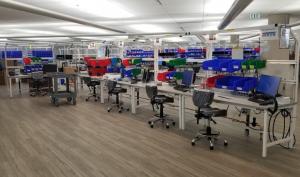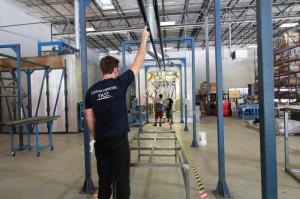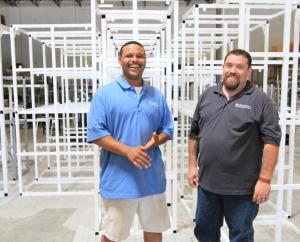How to Design a Flexible Factory

Formaspace shipped an initial order of 500 ESD workbenches in just 18 days for General Motors’ manufacturing facility in Kokomo, Indiana to produce Ventec critical care ventilators in response to the COVID-19.
Read more to find out what it takes to build a flexible manufacturing facility that can give you a strong competitive advantage over your competitors.
2020 and 2021 have been challenging years for manufacturing companies.
Thanks to the coronavirus pandemic, raw material shortages have torn through global supply chains – and it remains difficult to find enough highly skilled workers for today’s high-tech manufacturing facilities.
Given these challenges, manufacturing executives keep asking, “how can we make our factory is more flexible?”
Let’s take a moment to expand a bit on what managers might hope to achieve by creating flexible factories.
Here are some of the top reasons:
· Outflank The Competition With New And Varied Products
A flexible production system can help companies introduce highly differentiated products before their competitors do. Flexible manufacturing can also help create a wider product range to keep customers “within the family” and in and out of the hands of the competition.
· Match Production Levels With Changing Customer Demand
Flexible factories can respond quickly to rapid changes in customer demand by either increasing or decreasing the rate of production.
· Reduce On Hand Inventories (And Capital Carrying Costs)
Factories that can start and stop production quickly can avoid relying solely on long production runs – reducing inventory buildup and high capital carrying costs.
· Successfully Navigate Supply Chain Disruptions
In an ideal world, flexible factories can continue producing goods despite supply chain disruptions and production shutdowns, either by switching to alternative raw materials or parts or by quickly switching to the production of other products.
· Serve Profitable Custom Or Niche Markets
Manufacturing custom products to meet the unique needs of customers can be profitable if done efficiently at scale – without disrupting other production requirements. Serving long-tail markets with niche products can also be very profitable if the manufacturing facility can handle short production runs efficiently.
· Revive Sales Of Long-Established Products
Flexible factories can support sales campaigns that “juice” up demand for long-established products, for example, by producing limited edition production runs, often featuring unique colors or materials.
· Offer Unique Products For Each Sales Channel
Flexible factories can also produce differentiated products sold at different price points to address luxury and/or mass markets; geographical markets with unique requirements (such as RHD vehicles); or specific sales channels (such as wholesale, direct, retail, or e-commerce).
Requirement 1: Determine Your Flexible Manufacturing Goals
Now comes one of the hardest steps in pursuing a flexible manufacturing philosophy – identifying your key goals/justifications for creating a flexible factory – as well as how you plan to measure whether the program is ultimately successful or not.
“Why is this a difficult process?” you might ask.
As we’ll see in a second, there are a lot of competing ideas about what makes a successful flexible factory.
Here are just a few of the key goals that you could focus on:
· Goal A: Respond To Customer Orders Quickly By Switching From Producing One Product To Another
· Goal B: Create A Wide Product Range Based On A Core Product Competency
· Goal C: Create A Wide Product Range With Very Different Product Offerings
· Goal D: Introduce New All Products To The Range Without Disruption
· Goal E: Specialize In High Volume Production Of Individually Customized Products
After reading this list, you might say, “Great, I’ll take them all.”
But unfortunately, pursuing all these goals at one time will NOT lead to success.
It’s far better to make a careful assessment of your requirements and identify one crystal-clear goal that you can implement across the organization – starting (as we’ll see in the next section) with your workforce.
Requirement 2: Recruit, Train, And Retain A Flexible Workforce
What’s the most important investment you can make to create a successful flexible factory?
Is it investing in new industry 4.0 infrastructure or smart factory software?
The answer is no.
People are your most important investment.
· A Skilled Workforce Is The Most Important Ingredient For Flexible Factory Success
Operations and supply chain management expert David M. Upton really makes this clear in his classic study “What Really Makes Factories Flexible?” in which he takes an in-depth look at flexible production in the paper industry. He found that managers said 40% of their flexible factory initiatives were unsuccessful or disappointing. However, among successful projects, an experienced workforce that was trained to work toward specific flexibility was key – far more important than investing in software solutions or other technology.
· Ways To Overcome Manufacturing Worker Shortages
Of course, this poses a problem. As manufacturing companies are all too aware, skilled worker shortages are hitting the manufacturing industry especially hard.
A joint study by Deloitte and The Manufacturing Institute surveyed over 800 companies and found we could have 2.1 million unfilled manufacturing jobs by 2030.
What can we do about it? MIT proposed that we pursue more apprentice training programs along the lines of Germany. Meanwhile, the Manufacturing Institute (sponsor of Manufacturing Day) has created a #CreatorsWanted marketing campaign to drum up interest in manufacturing careers. (And if that isn’t enough, they suggest we consider giving felons a second chance in the job market.)
What can you do?
Sponsor local school programs by funding a Makerspace in your local high school or community college. Offer one-on-one mentoring programs for students and young graduates. Make your workplace friendly to those who are unfamiliar with factory settings; set a good example with a clean, attractive, and ergonomic workplace (this will help with worker retention as well).
· Double Down On Clear Worker Training To Meet Clear Flexibility Goals
The study by Upton mentioned above really emphasizes the importance of effective worker training. Workers who clearly understood management’s goals for achieving success in flexible production methods performed the best in achieving those goals.
Requirement 3: Implement Flexible Product Design
· Product Design Engineers Belong On The Factory Floor
Product designers and engineers need to be co-located on the factory floor with production managers, not in an office far away. (The only exception to this rule is when product designers leave the facility – to meet with end-users and suppliers, which they should do often.)
· Makerspaces Can Help Encourage Creative Solutions
Building a product development lab or makerspace adjacent to the production line is a good idea to allow engineers and production teams to work together to solve problems
· Design For Manufacturing (DFM) Is More Important Than Ever
Building products that are designed to be easily manufactured in the first place (using techniques as top-down assembly design) is an important foundation for flexible production. Many industries also design their products around core platforms that can be customized easily to extend the product range.
Read more...
Julia Solodovnikova
Formaspace
+1 800-251-1505
email us here
Visit us on social media:
Facebook
Twitter
LinkedIn
Legal Disclaimer:
EIN Presswire provides this news content "as is" without warranty of any kind. We do not accept any responsibility or liability for the accuracy, content, images, videos, licenses, completeness, legality, or reliability of the information contained in this article. If you have any complaints or copyright issues related to this article, kindly contact the author above.


